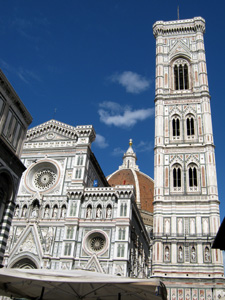
The Duomo
Back to Florence Continue to Santa Croce
The massive Basilica di Santa Maria del Fiore, commonly referred to as the Duomo, and associated structures, comprise the spiritual center of Florence, and their lengthy and eventful construction contributes a significant piece to the history of art and architecture. The Duomo itself is 502 feet long and 295 feet wide at its widest. On top of the Duomo is the world’s largest masonry dome (more than 143 feet in diameter), which has occupied its position, basically unchanged, since 1436. The dome, with its surmounting lantern, rises to a height of 375 feet. The elaborate (some have said excessively elaborate) fašade wasn’t added until the late 19th Century.
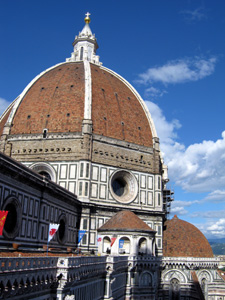 The Dome | 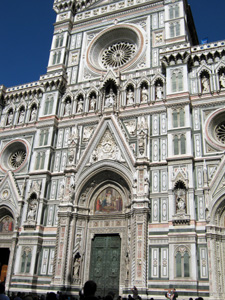 The Fašade |

The Fašade
HD Video (21.3 MB) SD Video (17.0 MB)
The multicolored marble used on the fašade was
selected to coordinate with the detached campanile standing next to the
Duomo. This campanile is 276 feet tall,
and was completed in 1359. Across from
the Duomo is the large, octagonal Battistero di San Giovanni, or Baptistery of
St. John. The baptistery was completed
in 1128, replacing an earlier baptistery which had stood on the same spot since
the 9th Century or earlier.
Decorating the baptistery are a number of statues, as well as bronze
doors which are masterworks of the genre.
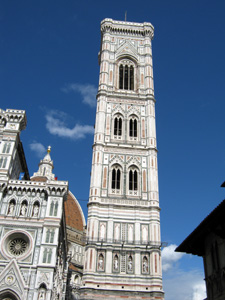
The Campanile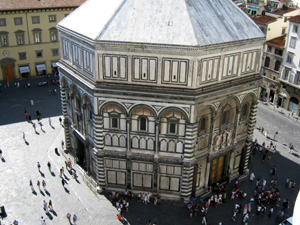
The Baptistery
Work
on the Duomo began in 1296, according to a design by Arnolfo di Cambio, and
continued for the ensuing century. The
artist Giotto, named to head the project in 1334, designed the campanile, which
was completed more than 20 years after his death. A design for the dome, which had been vague
up to this point, was submitted in 1367 by Neri di Fioravante. The design called for the largest dome that had
ever been built, octagonally sectioned and with no external buttressing (common
in Gothic architecture) to support it.
Everyone loved the design, but hadn’t a clue as to how to build it. The only existing dome approaching this size
was that of the Pantheon in
Jumping ahead to 1401, the Wool Merchants, still in denial about the dome, decided the baptistery needed a new set of bronze doors, with 14 panels per door, each depicting a scene from the Old Testament. A competition was announced in which artists were to submit a panel depicting the Sacrifice of Isaac, and a panel of 34 judges would award the commission to the artist whose panel was judged to be the best. The two finalists were two young goldsmiths named Lorenzo Ghiberti and Filippo Brunelleschi.
 Lorenzo Ghiberti (left) | 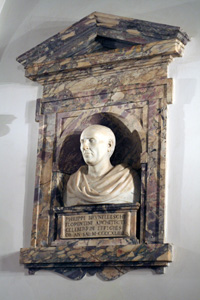 Filippo Brunelleschi |
Ghiberti and Brunelleschi didn’t like each
other very much, and the ensuing years would not bring any improvement to this
situation, but as events unfolded, they would find each other unavoidable,
pretty much for the remainder of their careers.
Ghiberti’s creative process for the 1401 competition was to show his
progress to other artists, several of whom were on the panel of judges, and
solicit and include their suggestions.
He’d mastered the difficult art of bronze casting, and was able to
produce his submission as a single piece.
Brunelleschi, on the other hand, was very secretive with his work, a
pattern he would follow throughout his career.
His technical ability with the casting was probably not as advanced as
Ghiberti’s, and his submission came in multiple pieces. However, the artistic quality of his
submission was such that the judges found themselves with a very difficult
choice. Their eventual conclusion was to
award the commission to Ghiberti, with Brunelleschi to assist.
Brunelleschi
responded by departing for
Skipping
to 1418, the construction on the Duomo was nearly finished, except for the
Elephant in the Room – the big open space where there was supposed to be a
dome. The Wool Merchants could no longer
avoid the issue, so they announced another competition. Ghiberti, though he was still working on the
doors and had limited architectural experience, had some ideas and entered the
competition. And, back from
Ghiberti
and Brunelleschi both held their noses and began work, and it quickly became
apparent that Brunelleschi had a much better handle on the job than
Ghiberti. The dome would have to be made
from bricks and mortar. Filippo had a
great many bricks cast in a particular way, and devised animal-driven,
counterweighted contrivances to move the bricks up and down between the ground
and the great heights at which the bricklayers would be working. There was not enough wood in all of
The two artists worked on their respective projects (as well as some smaller ones) over the next several years, and the dome was completed in 1436. There was another competition involving both artists for the lantern atop the dome, but Brunelleschi was the clear winner of this one. He died in 1446, shortly after the start of construction on the lantern, which wasn’t completed until 1461.
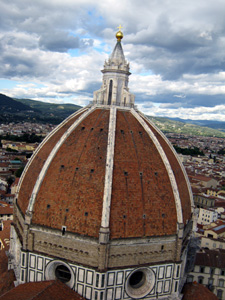 The Dome | 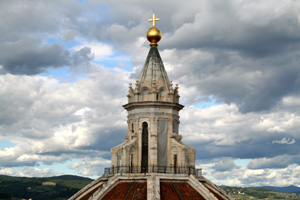 The Lantern |
A commission was awarded in 1469
to Andrea del Verrocchio for a large ball and cross to be placed atop the
lantern. Brunelleschi’s hoisting devices
were used in the placement, and an apprentice in Verrocchio’s workshop named
Leonardo da Vinci sketched pictures of them, as he thought they were really
cool.
In
the meantime, Ghiberti toiled for 27 years on the new baptistery doors, and
they were installed on the east side, facing the Duomo (the previous doors
being moved 90 degrees to the north) in 1452.
The new doors only displayed ten panels, but multiple scenes were shown
in each panel. They were revolutionary
in the field of bronzework, making use of the recent rediscovery (by Brunelleschi)
of linear perspective, with a result that was much more three-dimensional than
anything done in bronze to this point.
They received rave reviews, with people calling them “perfect” and the
greatest artwork ever. Decades later, no
less a critic than Michelangelo pronounced them fit to be the “Gates of
Paradise”, a name which has been applied to them ever since (one can imagine a
scene in Heaven, or wherever Ghiberti and Brunelleschi are, in which Lorenzo
elbows Filippo, points and says “See?”).

The Gates of Paradise
Adam and Eve Panel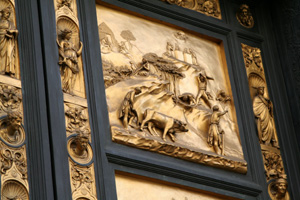
Cain and Abel Panel
Abraham and the Sacrifice of Isaac Panel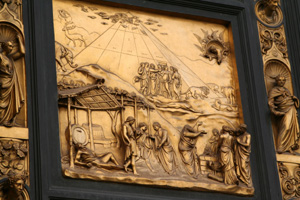
Noah Panel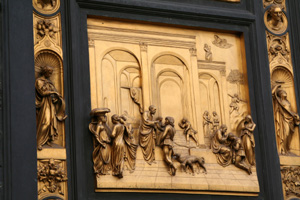
Esau and Jacob Panel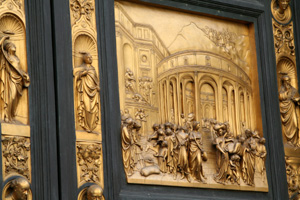
Joseph Panel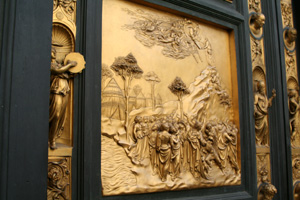
Moses Panel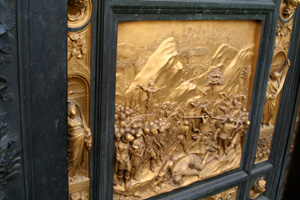
David and the Battle with the Philistines Panel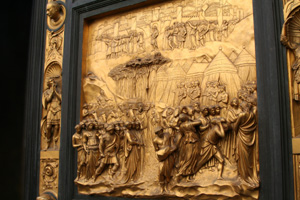
Joshua and the Fall of Jericho Panel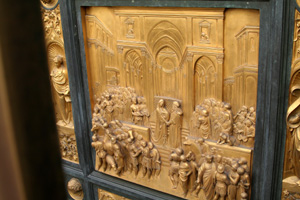
Solomon and the Queen of Sheba Panel
The Gates of Paradise
HD Video (19.0 MB) SD Video (7.8 MB)
We
dropped by the Duomo on two occasions.
The first, as mentioned above, was on the evening of our arrival in the
city. Before going to dinner we walked
around the baptistery, admiring Ghiberti’s sets of bronze doors. And across the piazza, we were dazzled by the
fašade of the Duomo, brilliantly lit by the setting sun. High atop the campanile next to the Duomo,
people could be seen. Connie and Bob
longed to be two of those people. Philip
and Nella, not so much. Unlike the
campanile we’d seen in
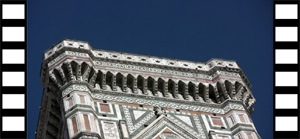 The Campanile HD Video (10.6 MB) SD Video (5.9 MB) | 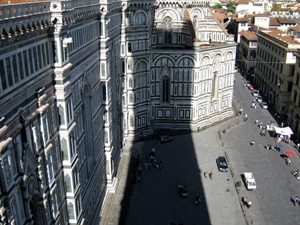 South Face of Duomo |
 View Through Campanile Window | 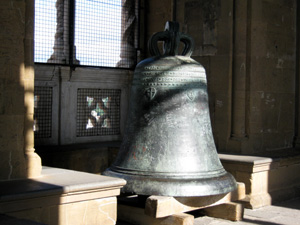 A Bell |
 Bob at the Top | 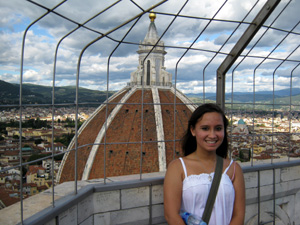 Connie and Dome |
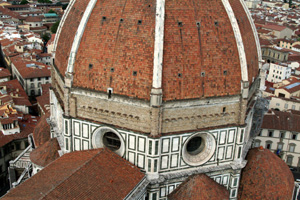 Base of Dome | 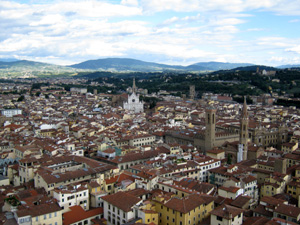 View to Southeast |
 Dome, Santa Croce Church and Bargello HD Video (17.2 MB) SD Video (7.7 MB) | 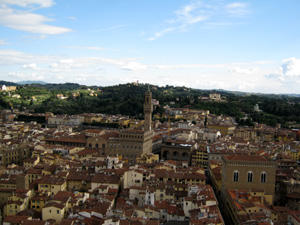 View Southward |
 Pitti Palace, Across River |  View to Southwest |
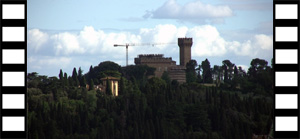 View to South and Southwest HD Video (14.2 MB) SD Video (6.4 MB) | 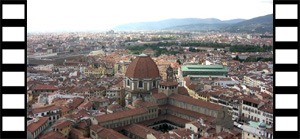 View to Northwest HD Video (16.6 MB) SD Video (8.6 MB) |
It’s normally possible to walk to the top of the dome instead (and
Connie indicated a desire to do just that), but there weren’t any people on the
dome, indicating that it was probably closed for the day. The dome viewpoint is a little higher than
the campanile, but it costs a couple of Euros more and normally has a longer
and slower line. And from the top of the
dome, you don’t really get a very good view of the dome. The view from the campanile was more than
satisfactory.
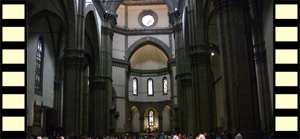 Inside the Duomo HD Video (12.8 MB) SD Video (4.8 MB) | 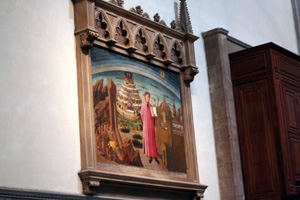 Dante and the Divine Comedy, Domenico di Michelino (1465) |
 Liturgical Clock | 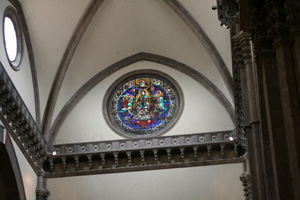 Stained Glass |
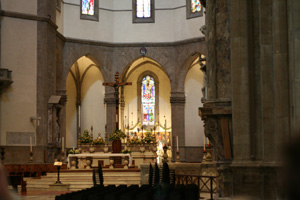 Main Altar | 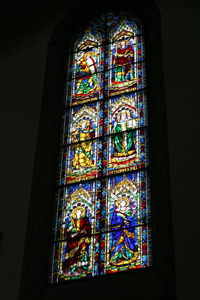 Stained Glass |
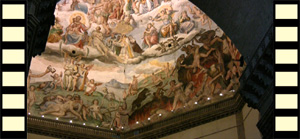 Altar and Dome Fresco HD Video (18.2 MB) SD Video (3.6 MB) | 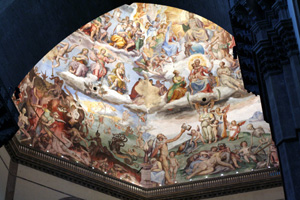 Dome Fresco, Vasari & Zuccari (1568-79) |